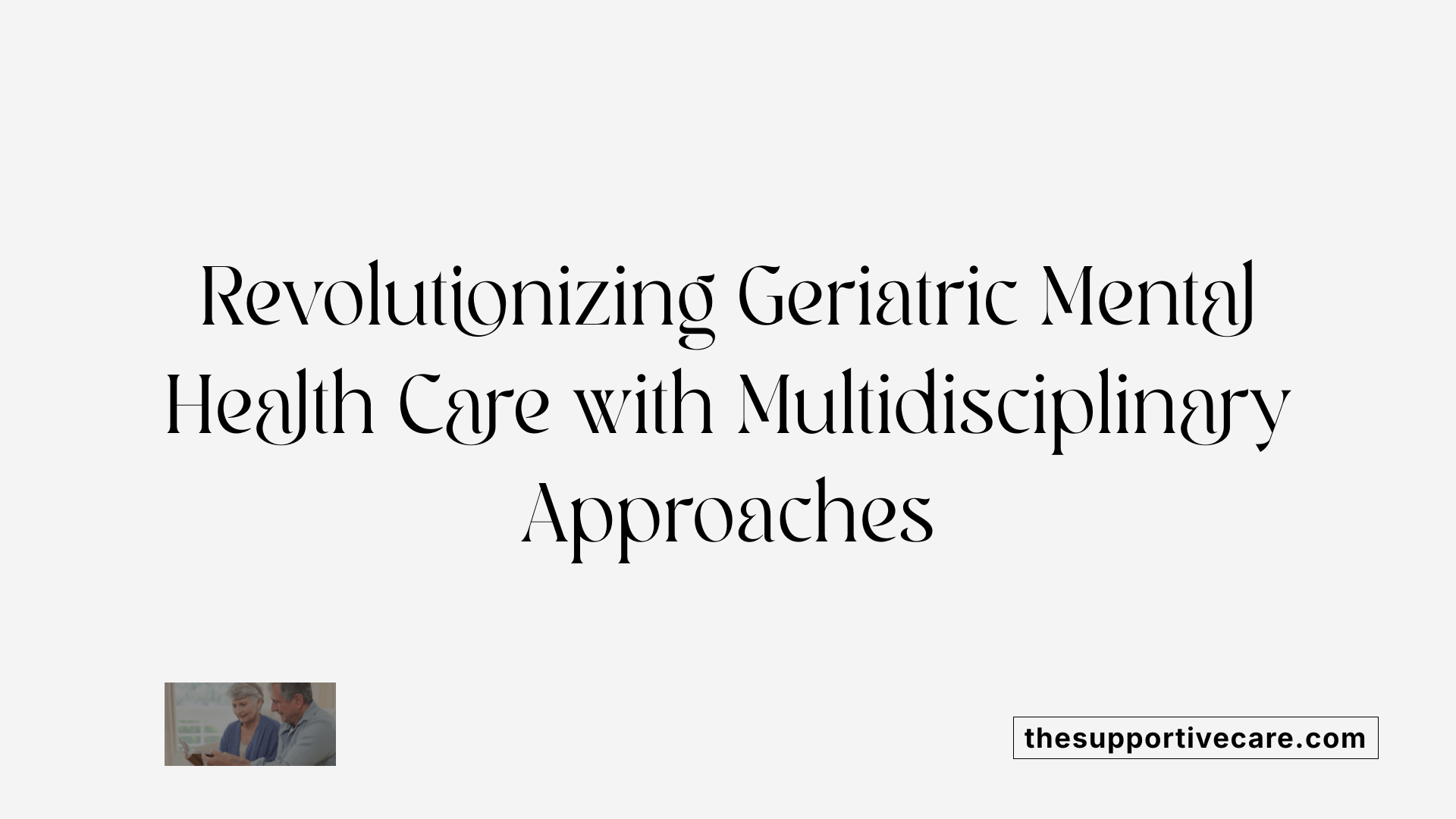The Complex Psychological Landscape of Aging
As the global population ages, understanding the psychological effects of aging is more important than ever. Older adults face a range of mental health challenges that can deeply impact their quality of life, including neurocognitive disorders, depression, and substance use disorders. This article explores the multifaceted nature of these issues, social determinants influencing mental health, and advances in comprehensive treatment services tailored to the aging population. Through a deeper examination of resilience, stigma, emerging therapies, and preventive strategies, we aim to shed light on the often overlooked mental health needs of older adults and the pathways toward successful aging.
Mental Health Challenges in Older Adults: Scope and Impact
What are common mental health challenges faced by older adults?
Older adults commonly face a range of mental health challenges that significantly affect their quality of life. Among the most prevalent are neurocognitive disorders such as Alzheimer's disease and other dementias. These conditions lead to progressive cognitive decline, memory loss, and impaired daily functioning.
Depression is another widespread issue, affecting approximately 2% of adults over 55, with rates rising as people age. Its causes relate to neurological changes, oxidative stress, and social factors. Schizophrenia, although less common in later life, presents challenges with symptoms fluctuating from remission to episodes requiring ongoing management.
Substance use disorders are increasingly seen in older adults, with approximately 1 in 11 individuals over 60 experiencing such disorders. Alcohol is the most frequently misused substance, with rising rates of binge and heavy drinking noted, especially among women. Use of cannabis and prescription medication misuse also contribute significantly to this group’s mental health burden.
Types of mental health conditions affecting aging populations
- Neurocognitive Disorders: Includes Alzheimer's disease and related dementias, highly prevalent due to population aging.
- Depression: Characterized by mood disturbances, often exacerbated by physical illness, isolation, and neurological changes.
- Schizophrenia and Psychotic Disorders: Present a diverse clinical course that requires careful pharmacological and psychosocial interventions.
- Substance Use Disorders: Encompassing alcohol misuse, prescription drug abuse, and illicit drug use, substantially impacting physical and mental health.
Impact on disability and quality of life
These mental health conditions contribute to significant disability among older adults, reducing independence and increasing the need for care. Cognitive decline from neurodegenerative diseases impairs functional abilities and safety. Depression and schizophrenia often reduce social engagement and self-care, intensifying isolation and vulnerability.
Substance abuse exacerbates existing health problems such as diabetes and cardiovascular disease, increases the risk of falls, and complicates medication management due to altered drug metabolism. The overall effect is a considerable burden on individuals, families, and healthcare systems, highlighting the urgent need for targeted mental health services and preventive strategies to improve well-being in aging populations.
Positive Aspects and Successful Aging: Resilience and Meaning
What factors contribute to successful aging?
Successful aging is a holistic concept that goes beyond just living longer; it emphasizes maintaining overall quality of life as people grow older. Key factors contributing to successful aging include maintaining subjective well-being, physical health, and cognitive function. Equally important are social engagement, resilience, wisdom, and a strong sense of meaning in life.
Resilience, the ability to bounce back from adversity, plays a vital role in helping older adults cope with challenges such as health issues or loss. Wisdom and prosocial behaviors—actions aimed at benefiting others—also contribute to positive mental health by fostering social connections and purposeful living.
Maintaining active social engagement helps combat loneliness and supports mental and emotional health. Together, these elements promote higher levels of subjective well-being, which refers to how individuals perceive and experience their own lives positively.
Research shows that older adults who embody these traits and maintain meaningful relationships tend to experience better mental health outcomes. This includes reduced risks for depression and cognitive decline, highlighting the protective effect of these psychological and social factors.
By focusing on resilience, wisdom, and social connectedness, interventions can be designed to encourage successful aging that enriches the mental health and life satisfaction of older adults.
Social Determinants Influencing Mental Health in Older Populations

How do social determinants affect mental health in older adults?
Social determinants profoundly impact the mental health of older adults by shaping their experiences and access to care. Factors like ageism and stigma contribute to marginalization, leading many older individuals to avoid seeking help for mental health issues due to fear of discrimination or shame.
Ageism and stigma effects
Ageism—prejudice or discrimination based on age—exacerbates mental health challenges for older adults by undermining their self-worth and reinforcing negative stereotypes. Stigma around mental illness further isolates those struggling, reducing their willingness to disclose symptoms or pursue treatment.
Social isolation and loneliness
Social isolation and loneliness are common among older populations, often due to the loss of loved ones, mobility challenges, or changes in living situations. These feelings are strongly linked to depression, cognitive decline, and increased mortality risk. Maintaining social engagement is critical for preserving mental well-being.
Healthcare disparities and workforce shortages
Disparities in mental health care access, including geographic, economic, and systemic barriers, disproportionately affect older adults. Workforce shortages of trained geriatric mental health professionals limit availability of appropriate interventions. This shortage contributes to longer wait times, inadequate treatment, and increased reliance on primary care providers who may not specialize in geriatric psychiatry.
Addressing these social determinants by combating stigma, fostering social connections, and expanding specialized mental health services is essential to improving mental health outcomes for the aging population.
Neurocognitive Disorders: Alzheimer's and Dementia Priorities

What are the priorities in addressing neurocognitive disorders in older adults?
Neurocognitive disorders, including Alzheimer's disease and related dementias, have become a significant concern as populations age worldwide. These disorders contribute greatly to disability and impairments among older adults, making them a critical focus in geriatric mental health.
Prevalence and Significance of Neurocognitive Disorders
With increasing longevity, the prevalence of neurocognitive disorders is rising sharply. Alzheimer's disease is the most common form, marked by progressive memory loss and cognitive decline. These disorders profoundly impact individuals' quality of life and impose substantial social and healthcare burdens.
Early Diagnosis Importance
Early detection of neurocognitive disorders is essential to improve outcomes. Timely diagnosis can help manage symptoms more effectively, allow better planning, and enable patients and their families to access support and resources earlier in the disease course.
Current Research on Biomarkers and Disease-Modifying Treatments
Cutting-edge research focuses on identifying biomarkers—biological indicators detectable through blood tests or imaging—to diagnose these diseases more confidently at earlier stages. Developing disease-modifying treatments that slow or halt the progression of Alzheimer’s and other dementias remains a high priority, as no definitive cure currently exists.
Preventive Strategies Against Dementia
Preventing or delaying the onset of neurocognitive disorders involves promoting healthy lifestyle choices across the lifespan. Key strategies include:
- Education: Lifelong learning stimulates cognitive reserve.
- Physical Activity: Regular exercise supports brain health.
- Control of Vascular Risk Factors: Managing hypertension, diabetes, and cholesterol reduces dementia risk.
- Healthy Behaviors: Balanced diet, social engagement, and mental stimulation contribute to resilience.
Though definitive prevention methods are still under study, these approaches show promise in reducing disease incidence and severity.
This multi-faceted prioritization—early diagnosis, biomarker research, treatment development, and prevention—forms the backbone of efforts to address the growing challenge of neurocognitive disorders among older adults.
Managing Depression and Schizophrenia in Late Life
How are depression and schizophrenia managed in older adults?
Depression affects about 2% of older adults above 55 years, with prevalence increasing as people age. Biological changes such as decreased GABAergic neurotransmission and increased oxidative stress contribute to its development. Despite these challenges, psychosocial interventions have been shown to be effective in managing depression. Cognitive-behavioral therapies (CBT) and community engagement activities promote emotional well-being and can improve quality of life for older individuals.
Schizophrenia in late life follows a variable course. Some patients experience periods of remission or stability, while others might have persistent symptoms that require ongoing care. The management of schizophrenia in this population involves careful pharmacotherapy tailored to minimize side effects and interactions, given older adults’ sensitivity to medications. Psychosocial support, including counseling and social services, is crucial to address the illness’s impact and improve functionality.
Addressing social determinants such as stigma, isolation, and healthcare access disparities plays a significant role in successful treatment outcomes. Collaborative care models that integrate primary care with psychiatric services, and interventions focusing on comorbidities, further enhance management efficacy. The combined approach of medication, psychotherapy, and social support helps older adults manage these complex mental health conditions more effectively.
The Rising Concern of Substance Use Disorders in Older Adults

What are substance use trends and challenges in older adults?
Substance use disorders (SUD) among older adults have become a growing public health issue. In 2022, about 1 in 11 adults over 60 were affected by substance misuse. This increasing trend is attributed partly to demographic changes such as the aging Baby Boomer generation, who exhibit higher rates of illicit drug use and substance experimentation than previous cohorts.
Prevalence and trends in substance misuse
Alcohol remains the most commonly misused substance in this population. Rates of binge and heavy drinking have notably increased, especially among older women, with approximately 19.6% of men and 6.3% of women engaging in binge drinking. Cannabis use among adults aged 65 and older surged 75% from 2015 to 2018, primarily for managing medical conditions such as pain, arthritis, sleep difficulties, anxiety, and depression.
Common substances abused
Besides alcohol and cannabis, prescription medication misuse—particularly opioids and benzodiazepines—is prevalent. Many older adults take multiple prescriptions, elevating risks for drug interactions and misuse. Tobacco use is also significant, with about 14% reporting past-year use.
Physiological changes influencing drug metabolism
Aging causes reduced lean muscle mass and declining liver function, impairing the metabolism of alcohol and drugs. These changes amplify the effects and dangers of substances, resulting in increased toxicity, higher risk of falls, cognitive decline, and adverse medication interactions.
Risk factors for substance misuse
Several social and personal factors heighten susceptibility to substance use disorders in older adults. These include bereavement, forced retirement, chronic health issues, social isolation, financial strain, and previous substance use history. Compounding these challenges are widespread ageism and stigma, which often discourage older adults from seeking help.
Addressing these trends demands routine screening and tailored interventions that consider the unique physiological and psychosocial needs of older adults to improve health outcomes and quality of life.
Barriers to Detection and Screening of Substance Misuse in Aging Populations
Why is substance misuse often under-recognized in older adults?
Substance misuse in older adults frequently goes unnoticed because many of its signs mimic normal aging or other health problems common in later life. Symptoms such as confusion, memory issues, or changes in mood might be wrongly attributed to aging or medication side effects rather than substance use.
Stigma plays a major role in under-recognition. Older adults often feel shame or fear judgment, which leads to reluctance in disclosing substance use or seeking help. This cultural silence limits opportunities for timely intervention.
Healthcare providers may also lack sufficient training or awareness, and routine screening for this group is often inadequate. Additionally, older adults tend to have reduced self-awareness regarding their substance use, compounding the detection challenge.
What screening tools are available specifically for older adults?
Several screening instruments have been developed or adapted to improve detection of substance misuse in aging populations:
| Screening Tool | Purpose and Use | Strengths and Limitations |
|---|---|---|
| CAGE-AID (CAGE-Adapted to Include Drugs) | Screens for alcohol and drug misuse | Simple and quick but may miss low-level use |
| MAST-G (Michigan Alcohol Screening Test-Geriatric Version) | Specialized for older adults' alcohol use | Sensitive to older adults’ patterns but longer to administer |
| AUDIT (Alcohol Use Disorders Identification Test) | Broad alcohol use screening | Effective for hazardous drinking but less focused on age-specific issues |
| ASSIST (Alcohol, Smoking and Substance Involvement Screening Test) | Covers multiple substances | Comprehensive but may require training to administer |
| CARET (Cut down, Annoyed, Guilty, Eye-opener, Risk) | Focuses on risks related to alcohol in older adults | Tailored to clinical risk factors but less widely used |
Using such tools in clinical and community settings can enhance early identification but requires education and proactive screening efforts tailored to older patients.
Overall, overcoming these detection barriers is crucial for addressing the growing problem of substance misuse among older adults, enabling timely and effective interventions.
Comprehensive Treatment Services for Substance Abuse and Mental Health in Older Adults
What Are Comprehensive Treatment Services for Substance Abuse and Mental Health Issues?
Comprehensive treatment services combine care for both substance abuse and mental health challenges, reflecting their frequent coexistence, especially in older adults. These integrated programs aim to address the complex, intertwined nature of addiction and mental disorders through coordinated approaches.
Components of Integrated Treatment
- Medical Detoxification: Safely managing withdrawal symptoms under medical supervision.
- Individualized Counseling and Therapy: Including cognitive-behavioral therapy, motivational interviewing, and supportive psychotherapy tailored for older adults.
- Medication Management: Use of pharmacological treatments such as buprenorphine and methadone, alongside other medications to address mental health symptoms and prevent relapse.
- Support Groups: Facilitating peer support to enhance social engagement and resilience.
Treatment Settings and Use of Telehealth
Treatment is available across multiple settings:
- Inpatient Programs: For intensive monitoring and stabilization.
- Partial Hospitalization and Outpatient Care: Providing structure while allowing patients to remain in their communities.
- Community-Based Programs: Leveraging local resources and social networks.
Telehealth has become an increasingly valuable tool, especially for older adults with mobility challenges or limited access to specialized care, enabling remote counseling, medication management, and support services.
Importance of Continuous Care and Access
Recognizing addiction as a chronic disease, these comprehensive services emphasize continuous care, including ongoing monitoring and relapse prevention. Regular screenings and early interventions are crucial due to age-related physiological changes that affect drug metabolism and increase vulnerability to side effects.
By integrating mental health and substance abuse treatments with flexibility in delivery and continuity, these services improve recovery outcomes and quality of life for older adults.
Innovations and Multidisciplinary Approaches in Treatment

What new treatment approaches improve outcomes for older adults with mental health and substance use disorders?
Recent advances in treating mental health and substance use disorders among older adults emphasize integrated and personalized care strategies that better reflect the complex needs of this population.
One effective innovation is the adoption of collaborative care models. These models coordinate primary care and mental health services, facilitating comprehensive management of conditions such as depression, neurocognitive disorders, and substance use disorders. Through this integration, patients receive timely evaluations, consistent follow-up, and streamlined treatment plans which contribute to improved clinical outcomes.
Supporting this are lay health workers and telepsychiatry, which broaden access to care, particularly in underserved areas. Lay health workers provide culturally sensitive support and psychoeducation, while telepsychiatry offers remote psychiatric consultations, reducing barriers related to mobility and geographic isolation.
Another innovation, measurement-based care, incorporates regular standardized assessments of symptoms and treatment effects. This systematic approach allows clinicians to tailor interventions dynamically, enhancing treatment responsiveness and efficacy.
Importantly, emerging research advocates for personalized, multidisciplinary interventions that consider the biological, psychological, and social contexts influencing each older adult. Such strategies involve collaboration among healthcare providers, mental health specialists, social workers, and community resources to address complex factors like comorbidities, social isolation, and stigma.
Together, these evolving approaches represent a transformative shift towards more adaptive, holistic, and patient-centered management for mental health and substance use disorders in later life.
Prevention, Early Intervention, and Family Involvement in Supporting Mental Health

How can prevention and early intervention support mental health and substance use treatment in older adults?
Prevention and early intervention play a vital role in addressing mental health and substance use disorders among older adults. Education on the risks associated with substance use, such as the amplified effects of alcohol and medication interactions due to aging physiology, helps older individuals make informed choices.
Routine screening, using tools like the CAGE-AID and MAST-G, allows for early detection of substance misuse and mental health issues which are often hidden or mistaken for normal aging. Brief motivational interviewing and tailored psychosocial therapies enhance the effectiveness of early treatment efforts.
The active involvement of families and communities provides essential emotional support and helps reduce stigma, which is a major barrier preventing many older adults from seeking help. Social engagement fosters resilience and promotes prosocial behaviors that improve well-being and mental health outcomes.
Overall, integrating education, early detection, family support, and stigma reduction forms a comprehensive approach that not only aids recovery but also strengthens the protective factors associated with successful aging, such as wisdom and psychological resilience.
Looking Ahead: Supporting Mental Health Through the Aging Journey
Understanding the psychological effects of aging reveals a complex interplay of mental health challenges and resilience. As the population ages, addressing neurocognitive disorders, depression, schizophrenia, and rising substance use requires integrated, evidence-based, and compassionate care approaches. Overcoming barriers like stigma, social isolation, and inadequate screening is essential to connect older adults with comprehensive treatment services that recognize their unique needs. Innovations in personalized, multidisciplinary care and early intervention offer hope for improved quality of life and successful aging. By fostering social engagement, promoting resilience, and enhancing healthcare access, society can better support the mental well-being of older adults and address the evolving challenges of aging with dignity and health.




































































































